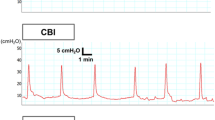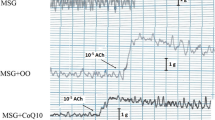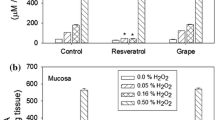Abstract
Purpose Ischemia, reperfusion, and free radical generation have been recently implicated in the progressive bladder dysfunction. Coenzyme Q10 (CoQ10) is a pro-vitamin like substance that appears to be efficient for treatment of neurodegenerative disorders and ischemic heart disease. Our goal was to investigate the potential protective effect of CoQ10 in a rabbit model of in vivo bilateral ischemia and ischemia/reperfusion (I/R). Material and Methods Six groups of four male New Zealand White rabbits each were treated with CoQ10 (3 mg/kg body weight/day—dissolved in peanut oil) (groups 1–3) or vehicle (peanut oil) (groups 4–6). Groups 1 and 4 (ischemia-alone groups) had clamped bilateral vesical arteries for 2 h; in groups 2 and 5 (I/R groups), bilateral ischemia was similarly induced and the rabbits were allowed to recover for 2 weeks. Groups 3 and 6 were controls (shams) and were exposed to sham surgery. The effects on contractile responses to various stimulations and biochemical studies such as citrate synthase (CS), choline acetyltransferase (ChAT), superoxide dismutase (SOD), and catalase (CAT) were evaluated. The protein peroxidation indicator, carbonyl group, and nitrotyrosine contents were analyzed by Western blotting. Results Ischemia resulted in significant reductions in the contractile responses to all forms of stimulation in vehicle-fed rabbits, whereas there were no reductions in CoQ10-treated rabbits. Contractile responses were significantly reduced in vehicle-treated I/R groups, but significantly improved in CoQ10-treated rabbits. Protein carbonylation and nitration increased significantly in ischemia-alone and I/R bladders; CoQ10 treatment significantly attenuated protein carbonylation and nitration. CoQ10 up-regulated SOD and CAT activities in control animals; the few differences in CoQ10-treated animal in SOD and CAT after ischemia and in general increase CAT activities following I/R. Conclusions CoQ10 supplementation provides bladder protection against I/R injury. This protection effect improves mitochondrial function during I/R by repleting mitochondrial CoQ10 stores and potentiating their antioxidant properties.








Similar content being viewed by others
References
Levin R, Chichester P, Levin S, Buttyan R (2004) Role of angiogenesis in bladder response to partial outlet obstruction. Scand J Urol Nephrol Suppl 215:37–47
Changolkar AK, Hypolite JA, Disanto M et al (2005) Diabetes induced decrease in detrusor smooth muscle force is associated with oxidative stress and overactivity of aldose reductase. J Urol 173:309–313
Azadzoi KM, Yalla SV, Siroky MB (2007) Oxidative stress and neurodegeneration in the ischemic overactive bladder. J Urol 178:710–715
Azadzoi KM, Tarcan T, Kozlowski R et al (1999) Overactivity and structural changes in the chronically ischemic bladder. J Urol 162:1768–1778
Greenland JE, Brading AF (2001) The effect of bladder outflow obstruction on detrusor blood flow changes during the voiding cycle in conscious pigs. J Urol 165:245–248
Greenland JE, Hvistendahl JJ, Andersen H et al (2000) The effect of bladder outlet obstruction on tissue oxygen tension and blood flow in the pig bladder. BJU Int 85:1109–1114
Lin AD, Mannikarottu A, Chaudhry A et al (2005) Protective effects of grape suspension on in vivo ischaemia/reperfusion of the rabbit bladder. BJU Int 96:1397–1402
Erdem E, Leggett R, Dicks B et al (2005) Effect of bladder ischaemia/reperfusion on superoxide dismutase activity and contraction. BJU Int 96:169–174
Matsumoto S, Hanai T, Yoshioka N et al (2005) Edaravone protects against ischemia/reperfusion-induced functional and biochemical changes in rat urinary bladder. Urology 66:892–896
Levin RM, Whitbeck C, Horan P et al (2005) Low-dose tadenan protects the rabbit bladder from bilateral ischemia/reperfusion-induced contractile dysfunction. Phytomedicine 12:17–24
Crane FL (2001) Biochemical functions of coenzyme Q10. J Am Coll Nutr 20:591–598
Hargreaves IP, Heales S (2002) Statins and myopathy. Lancet 359:711–712
Ochoa JJ, Quiles JL, Huertas JR et al (2005) Coenzyme Q10 protects from aging-related oxidative stress and improves mitochondrial function in heart of rats fed a polyunsaturated fatty acid (PUFA)-rich diet. J Gerontol A Biol Sci Med Sci 60:970–975
Moon Y, Lee KH, Park JH et al (2005) Mitochondrial membrane depolarization and the selective death of dopaminergic neurons by rotenone: protective effect of coenzyme Q10. J Neurochem 93:1199–1208
Greenberg S, Frishman WH (1990) Co-enzyme Q10: a new drug for cardiovascular disease. J Clin Pharmacol 30:596–608
Shults CW (2003) Coenzyme Q10 in neurodegenerative diseases. Curr Med Chem 10:1917–1921
Weant KA, Smith KM (2005) The role of coenzyme Q10 in heart failure. Ann Pharmacother 39:1522–1526
Singh RB, Shinde SN, Chopra RK et al (2000) Effect of coenzyme Q10 on experimental atherosclerosis and chemical composition and quality of atheroma in rabbits. Atherosclerosis 148:275–282
Aebi H (1984) Catalase in vitro. Methods Enzymol 105:121–126
Hsu TH, Levin RM, Wein AJ et al (1994) Alterations of mitochondrial oxidative metabolism in rabbit urinary bladder after partial outlet obstruction. Mol Cell Biochem 141:21–26
Bratslavsky G, Kogan BA, Matsumoto S et al (2003) Reperfusion injury of the rat bladder is worse than ischemia. J Urol 170:2086–2090
Murin R, Drgova A, Kaplan P et al (2001) Ischemia/Reperfusion-induced oxidative stress causes structural changes of brain membrane proteins and lipids. Gen Physiol Biophys 20:431–438
Somayajulu M, McCarthy S, Hung M et al (2005) Role of mitochondria in neuronal cell death induced by oxidative stress; neuroprotection by Coenzyme Q10. Neurobiol Dis 18:618–627
Azadzoi KM, Shinde VM, Tarcan T et al (2003) Increased leukotriene and prostaglandin release, and overactivity in the chronically ischemic bladder. J Urol 169:1885–1891
Azadzoi KM, Heim VK, Tarcan T et al (2004) Alteration of urothelial-mediated tone in the ischemic bladder: role of eicosanoids. Neurourol Urodyn 23:258–264
Yalcin A, Kilinc E, Sagcan A et al (2004) Coenzyme Q10 concentrations in coronary artery disease. Clin Biochem 37:706–709
Lenaz G, Battino M, Castelluccio C et al (1990) Studies on the role of ubiquinone in the control of the mitochondrial respiratory chain. Free Radic Res Commun 8:317–327
Crestanello JA, Doliba NM, Doliba NM et al (2002) Effect of coenzyme Q10 supplementation on mitochondrial function after myocardial ischemia reperfusion. J Surg Res 102:221–228
Modi K, Santani DD, Goyal RK et al (2006) Effect of coenzyme Q10 on catalase activity and other antioxidant parameters in streptozotocin-induced diabetic rats. Biol Trace Elem Res 109:25–34
Kershen RT, Azadzoi KM, Siroky MB (2002) Blood flow, pressure and compliance in the male human bladder. J Urol 168:121–125
Cetinel S, Ercan F, Sirvanci S et al (2003) The ameliorating effect of melatonin on protamine sulfate induced bladder injury and its relationship to interstitial cystitis. J Urol 169:1564–1568
Romanenko A, Morimura K, Wanibuchi H et al (2000) Increased oxidative stress with gene alteration in urinary bladder urothelium after the Chernobyl accident. Int J Cancer 86:790–798
Beshay E, Carrier S (2004) Oxidative stress plays a role in diabetes-induced bladder dysfunction in a rat model. Urology 64:1062–1067
Acknowledgments
This material is based upon work supported in part by the Office of Research and Development Medical Research Service, Department of Veteran’s Affairs; in part by NIH grant RO-1-DK 067114.
Author information
Authors and Affiliations
Corresponding author
Rights and permissions
About this article
Cite this article
Juan, YS., Hydery, T., Mannikarottu, A. et al. Coenzyme Q10 protect against ischemia/reperfusion induced biochemical and functional changes in rabbit urinary bladder. Mol Cell Biochem 311, 73–80 (2008). https://doi.org/10.1007/s11010-007-9696-y
Received:
Accepted:
Published:
Issue Date:
DOI: https://doi.org/10.1007/s11010-007-9696-y




